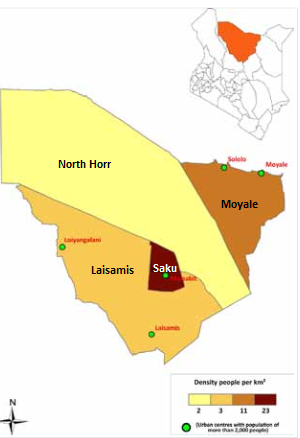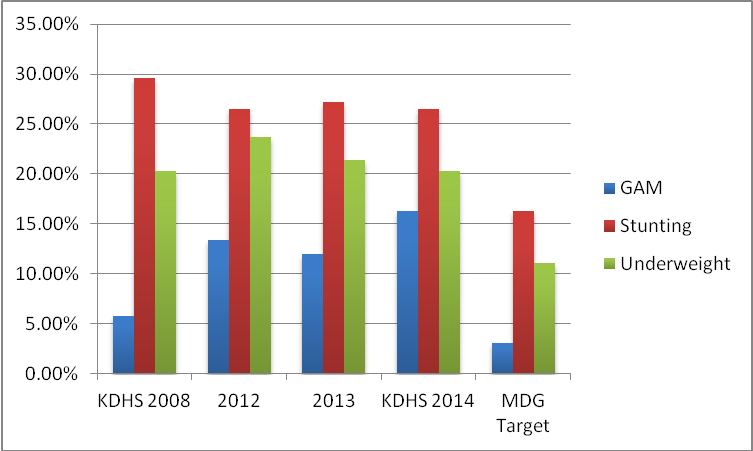Background
Marsabit County is located in the upper eastern region of Kenya. It borders  Ethiopia to the North, Wajir to the north east, Isiolo to the south East, Samburu to the south east and Turkana to the west. It covers an area of 70,961.2km2 and lies between latitude 10 58’N and 20 1’ S and longitude 380 34’E and 410 32’E. The County has four (4) sub counties namely North Horr, Moyale, Saku and Laisamis. The total population of the county is 343,636 projected from 2009 census. This population is projected to grow to 348,262 by 2018 (Census 2009). 21.3% of this population are women of the reproductive age while children under five years form 19.5%.The county has four major livelihoods zones including: pastoralists, agro-pastoralists, fisheries and urban segregated in different proportions as Pastoralists 81%, Agro-pastoralists 16 % and others (formal employment, casual wage labor, petty trade & fisheries )3%. Pastoralists dominate almost all parts of the four sub-counties with agro-pastoralists mostly notable in Saku and some parts of Moyale sub-counties while others are mainly notable in urban areas mainly the county and sub-county capitals.
Ethiopia to the North, Wajir to the north east, Isiolo to the south East, Samburu to the south east and Turkana to the west. It covers an area of 70,961.2km2 and lies between latitude 10 58’N and 20 1’ S and longitude 380 34’E and 410 32’E. The County has four (4) sub counties namely North Horr, Moyale, Saku and Laisamis. The total population of the county is 343,636 projected from 2009 census. This population is projected to grow to 348,262 by 2018 (Census 2009). 21.3% of this population are women of the reproductive age while children under five years form 19.5%.The county has four major livelihoods zones including: pastoralists, agro-pastoralists, fisheries and urban segregated in different proportions as Pastoralists 81%, Agro-pastoralists 16 % and others (formal employment, casual wage labor, petty trade & fisheries )3%. Pastoralists dominate almost all parts of the four sub-counties with agro-pastoralists mostly notable in Saku and some parts of Moyale sub-counties while others are mainly notable in urban areas mainly the county and sub-county capitals.
Nutrition situation in Marsabit County
Acute malnutrition and stunting have severe and adverse negative consequences on health of an individual, both in the short and long term. These include but not limited to impaired growth and development, increased vulnerability to infections, poor mental and cognitive development, low productivity and work output. Available evidence shows that effects of stunting are extremely difficult to revert in adulthood. Only appropriate and timely interventions during antenatal, delivery and the first two years of life (the first 1000 days of life) can make a huge difference in preventing stunting (UNICEF, 2010). As such, the first 1000 days of life is the most critical window of opportunity for addressing stunting. Sadly, despite the inclusion of height measurement into the national Mother Child Health Booklet, assessment of stunting is yet to pick up fully among health care providers in the County. Weight measurement as opposed to height measurement is given the priority for growth monitoring; therefore addressing stunting in the County will require a deliberate and concerted effort as well as paradigm shift in health care service delivery system.
Although the prevalence of NCD in the region is low, they are increasingly becoming common especially in urban centers in the county. This may be attributed to excessive energy intake associated with consumption of purchased meals, use of processed foods and decreasing levels of physical activity in urban settings. Changing lifestyles and eating habits have resulted in non-communicable diseases including cardiovascular, cancers, diabetes that closely related to obesity and represent a significant development challenge. Monitoring and screening for NCD is not routinely done and as such early detection and prevention measure are poorly instituted. Overweight and obesity are risk factors for non-communicable diseases such as hypertension, diabetes and cardiovascular diseases. According to WHO 28 % of all deaths result from NCD’s.
[2] KDHS 2014
Trends of Acute Malnutrition in Marsabit County (2012-2014)

In addition to chronic and acute malnutrition, micronutrient deficiencies remain a major problem nationally and by extension in Marsabit County. Results of the last national micronutrient survey conducted in 1999, found that micronutrient deficiencies, particularly vitamin A, Iron, Iodine and Zinc were highly prevalent among children < 5 and Women. Vitamin A deficiency (VAD) was high among pre-scholars; with 14.7% having acute and 61.2% moderate VAD. Among mothers, the prevalence of acute and moderate VAD was 9.1% and 29.6% respectively. Other common deficiencies were iron deficiency anaemia (IDA), iodine deficiency disorders (IDD) and zinc deficiency.; IDA among children 6-72 month olds and among pregnant women, were 84.4%, 69% and 55.1%, respectively; while IDD (36.8%); and zinc deficiency among mothers (52%) and among children under 5 years (51%). Currently there is lack of disaggregated data on the prevalence of micronutrient deficiencies in Marsabit County. However, with high prevalence of micronutrient deficiencies among <5’s and women nationally, it is worrying to note that coverage for routine vitamin A supplementation (VAS) and Iron Folic Acid Supplementation (IFAS) programs targeting < 5 and pregnant and lactating women, respectively in the County is below the national set target of 80%. There is greater need for a deliberate effort to accelerate routine micronutrient supplementation coverage through existing health system structures in Marsabit.
Major causes of malnutrition in the County include; food insecurity due to recurrent drought, sub optimal infant, young child and maternal feeding and care practices, poor access to quality health services and safe water, poor hygiene, and sanitation and poor dietary diversity. Globally, malnutrition is the single greatest contributor to child mortality at 53% (WHO, 2010).
